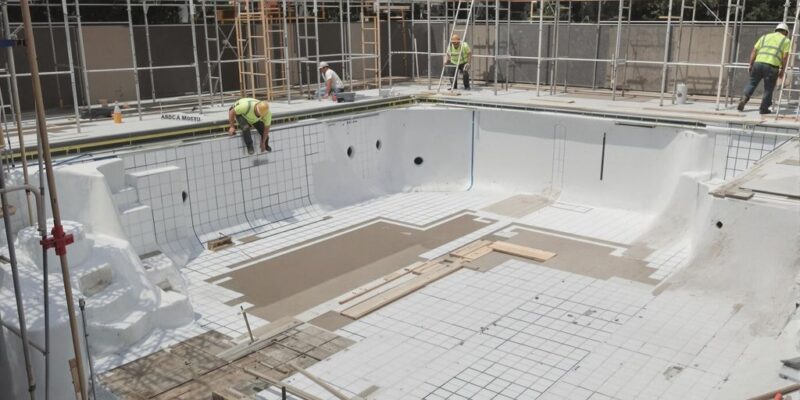Historical Use of Asbestos in Pool Materials
Asbestos, once hailed for its durability and resistance to heat and chemicals, found its way into countless construction applications, including swimming pools. Back in the mid-20th century, it was common to see asbestos woven into pool plaster, tiles, and adhesives. These materials were chosen for their ability to withstand harsh pool environments, such as high moisture levels and constant chemical exposure. However, with time, the health risks associated with asbestos became evident, leading to a decline in its usage.
Reasons for Incorporating Asbestos in Pool Construction
The decision to use asbestos in pool construction wasn’t arbitrary. Builders valued its unique properties, such as:
- Heat resistance, ensuring pool components could endure high temperatures without degrading.
- Chemical stability, making it suitable for areas exposed to pool cleaning agents.
- Cost-effectiveness, as asbestos was relatively affordable compared to other materials.
These factors made asbestos an attractive option for pool installations, especially during the mid-1900s when awareness of its dangers was limited.
Common Pool Components Containing Asbestos
Several elements of older swimming pools might still contain asbestos today. These include:
- Pool plaster finishes, including products like MarbleSheen, which often had asbestos mixed in for added strength.
- Adhesives and grouts used in securing pool tiles.
- Equipment like filtration systems and piping, where asbestos cement was employed for its durability.
If you suspect the presence of asbestos in any of these areas, it’s crucial to consult a professional for proper assessment. Hiring an abatement contractor ensures that any asbestos cleanup plan is handled safely and in compliance with regulations.
Health Risks Associated with Asbestos in Swimming Pools
How Asbestos Exposure Occurs in Pools
Asbestos exposure in swimming pools can happen in several ways, particularly during maintenance or renovation activities. Over time, pool materials containing asbestos may degrade, releasing tiny fibers into the air. When these fibers are inhaled, they can pose serious health risks. Actions like sanding, drilling, or cutting asbestos-containing surfaces significantly increase the chance of fiber release. Even water splashing against deteriorating materials can dislodge asbestos fibers, making proper handling of such materials essential.
Long-Term Health Implications of Asbestos
The health effects of asbestos exposure are severe and often irreversible. Inhaled fibers can lodge in the lungs, leading to inflammation, scarring, and diseases that may not appear until decades later. Conditions such as asbestosis, lung cancer, and mesothelioma are directly linked to prolonged asbestos exposure. Mesothelioma, in particular, is a rare but aggressive cancer that primarily affects the lining of the lungs and abdomen. Even short-term exposure can carry risks, especially if the fibers are disturbed and become airborne.
Vulnerable Groups and Risk Factors
Certain groups are more susceptible to asbestos-related health issues. Pool maintenance workers, contractors, and anyone involved in renovations are at higher risk due to frequent exposure to asbestos-containing materials. Additionally, older adults and individuals with pre-existing respiratory conditions may experience more severe health effects. Children are also particularly vulnerable, as their developing lungs are more sensitive to airborne toxins. Recognizing these risk factors underscores the importance of stringent safety measures when dealing with asbestos in swimming pools.
Identifying Asbestos in Swimming Pool Installations
Signs of Asbestos in Pool Materials
Recognizing asbestos in swimming pools isn’t straightforward, especially in older pools where materials have aged or been replaced over time. Visual identification alone is unreliable, as asbestos fibers are microscopic and often mixed into other materials. However, some clues might suggest its presence:
- Pool plaster or finishes that are deteriorating or crumbling, particularly in pools built before the 1990s.
- Adhesives or grout around tiles that appear brittle or powdery.
- Older pool equipment or piping that includes cement-based components.
If you notice any of these signs, it’s essential to avoid disturbing the area, as this could release asbestos fibers into the air.
Professional Testing for Asbestos
The only way to confirm the presence of asbestos is through professional testing. Certified asbestos inspectors can:
- Collect small samples from suspected materials without causing unnecessary damage.
- Send these samples to a specialized laboratory for analysis.
- Provide a detailed report on whether asbestos is present and its concentration levels.
Testing is especially recommended for pools constructed before asbestos bans were widely implemented. If you’re unsure, err on the side of caution and consult a professional.
Challenges in Identifying Asbestos
Identifying asbestos in swimming pools comes with its own set of challenges:
- Hidden Materials: Asbestos may be present in layers beneath visible surfaces, such as under tiles or within pool plaster.
- Lack of Documentation: Many older pools lack records detailing the materials used during construction or renovation.
- Risk of Exposure: Attempting to identify asbestos without proper equipment or expertise can disturb the material, increasing the risk of fiber release.
Given these challenges, it’s always safer to rely on experts. They have the tools and knowledge to identify asbestos without putting anyone’s health at risk.
Regulations and Guidelines on Asbestos Use in Pools
Global Bans and Restrictions on Asbestos
Over time, many countries have implemented strict bans or restrictions on asbestos use due to its severe health risks. For instance, in the United States, the EPA’s 2019 final rule prohibits certain uses of asbestos that are not already banned or regulated under other laws. Similarly, countries like Australia and the European Union have outlawed asbestos entirely. These measures aim to protect public health and reduce the risk of exposure in both residential and commercial environments, including swimming pools.
Impact of Regulations on Pool Construction
The shift in regulations has significantly altered how pools are designed and constructed. Older pools often incorporated asbestos in materials like plaster, tiles, and adhesives. With bans in place, modern pool construction has transitioned to safer, asbestos-free alternatives. This change not only improves safety but also ensures compliance with legal standards. However, for older installations, the presence of asbestos remains a concern, particularly during renovations or repairs.
Compliance Requirements for Pool Owners
For pool owners, staying compliant with asbestos regulations involves several steps:
- Inspection and Testing: Regularly check for potential asbestos-containing materials in older pools, especially if the pool was built before the 1980s.
- Safe Renovation Practices: Engage certified professionals to handle any repairs or upgrades involving asbestos materials.
- Proper Documentation: Maintain records of inspections, tests, and any asbestos-related work to ensure compliance with local laws.
By following these guidelines, pool owners can minimize health risks and align with regulatory requirements.
Common Locations of Asbestos in Swimming Pools
Asbestos in Pool Plaster and Finishes
Asbestos was widely used in pool plasters, including decorative finishes like MarbleSheen. This material, once popular for its durability and smooth appearance, often contained asbestos fibers to enhance its strength and resistance to chemicals. Over time, wear and tear can cause these plasters to degrade, potentially releasing harmful fibers into the environment.
Presence in Pool Tiles and Adhesives
Older pool tiles and the adhesives used to secure them are another common source of asbestos. The backing material of tiles and the bonding agents often included asbestos for its heat-resistant and adhesive properties. If these materials crack or deteriorate, they can pose a risk of asbestos exposure, especially during renovations or repairs.
Asbestos in Pool Equipment and Piping
Pool equipment and piping systems, particularly those installed before the 1980s, may also contain asbestos. Asbestos cement was frequently used in the construction of skimmer boxes, pipes, and other components due to its durability and resistance to water and chemicals. Routine inspections are essential to identify and manage any potential risks associated with these materials.
Safety Measures for Managing Asbestos in Pools
Regular Inspections and Maintenance
To keep asbestos risks under control, regular inspections are key. Older pools, particularly those built before the 1980s, are more likely to contain asbestos in their materials. Pool owners should schedule periodic checks to monitor the condition of plaster, tiles, and equipment. If any material appears damaged or deteriorating, it may release harmful fibers into the air. Hiring a professional inspector trained in asbestos detection ensures thorough and accurate assessments.
Safe Handling of Asbestos Materials
When dealing with asbestos-containing materials, safety should always come first. Individuals working near these materials must wear proper protective gear, including disposable clothing and headgear, as required by OSHA regulations. This minimizes direct contact and prevents the spread of fibers. Avoid actions like sanding or drilling, as they can disturb the materials and release fibers into the air. Instead, consult professionals for any repairs or modifications involving asbestos.
Preventing Asbestos Fiber Release
Preventing the release of asbestos fibers is critical in maintaining a safe pool environment. Simple measures, like keeping the pool filled with water, can help reduce fiber dispersion. If renovations or repairs are needed, sealing off the work area and using specialized equipment to contain fibers is essential. Water management practices, such as minimizing splashing in areas with potential asbestos exposure, can also reduce risks. For severe cases, consult certified experts to manage the situation effectively.
Options for Addressing Asbestos in Swimming Pools
Encapsulation of Asbestos Materials
One method to manage asbestos in swimming pools is encapsulation. This involves sealing asbestos-containing materials with a protective coating to prevent the release of harmful fibers. Encapsulation is often considered a temporary solution, as it does not remove the asbestos but rather contains it. Regular inspections are essential to ensure the encapsulated material remains intact over time.
Resurfacing Pools to Remove Asbestos
Resurfacing is another effective option, particularly for older pools with asbestos-based plaster or finishes. The process involves removing the damaged or outdated surface and replacing it with modern, asbestos-free materials. This approach not only eliminates the asbestos risk but also gives the pool a refreshed look. While resurfacing can be costly, it is a long-term solution that addresses both safety and aesthetic concerns.
Professional Asbestos Removal Services
For a permanent solution, hiring certified professionals to remove asbestos is the most reliable choice. These experts use specialized equipment and follow strict safety protocols to ensure the safe extraction and disposal of asbestos materials. Professional removal is particularly important for high-risk areas, such as damaged tiles, adhesives, or equipment containing asbestos. Although this method can be more expensive, it effectively eliminates the health risks associated with asbestos exposure.
Managing asbestos in swimming pools requires careful consideration of these options. Whether choosing encapsulation, resurfacing, or full removal, pool owners should prioritize safety and consult with certified asbestos professionals to determine the best course of action.
The Shift Away from Asbestos in Modern Pool Construction
Emergence of Asbestos-Free Alternatives
Asbestos was once a go-to material for swimming pool construction, thanks to its affordability and durability. However, as the dangers of asbestos exposure became evident, the industry began searching for safer options. Today, asbestos-free materials dominate the market, offering similar benefits without the health risks. These alternatives include fiberglass-reinforced plastics, durable ceramics, and advanced polymers. Pool builders now prioritize materials that are not only safe but also sustainable, ensuring long-term use without compromising health.
Trends in Eco-Friendly Pool Materials
The push for safer materials has also aligned with a growing demand for eco-friendly construction practices. Modern pool designs often incorporate green materials, such as recycled glass tiles or natural stone finishes, which are free from harmful substances like asbestos. Additionally, innovations in water filtration and energy-efficient heating systems complement these eco-conscious trends, making today’s pools both safer and environmentally responsible.
Lessons Learned from Past Practices
The widespread use of asbestos in the past serves as a cautionary tale for the construction industry. It highlights the importance of evaluating the long-term health impacts of building materials. Pool construction has come a long way, with stricter regulations and better awareness shaping safer practices. By learning from these past mistakes, the industry ensures that future projects prioritize safety, sustainability, and innovation.
Understanding the Composition of MarbleSheen and Its Risks
What is MarbleSheen?
MarbleSheen is a type of decorative finish commonly used for the interiors of concrete swimming pools. It’s made by mixing crushed white marble dust with cement, resulting in a smooth, durable surface that offers a polished aesthetic. This material became popular due to its ability to withstand wear and tear, as well as its elegant appearance.
Historical Use of Asbestos in MarbleSheen
In the past, asbestos was sometimes added to MarbleSheen mixtures. The reasoning? Asbestos fibers were known to enhance the material’s strength and resistance to chemicals. This made it a practical choice for pool finishes in the mid-20th century, especially when durability was a key concern. However, as the health risks of asbestos became widely recognized, the use of such mixtures was phased out. Unfortunately, older pools may still contain this hazardous material, posing potential risks.
Health Concerns Linked to MarbleSheen
The primary danger of asbestos-containing MarbleSheen lies in the release of asbestos fibers. When the material degrades over time or is disturbed during renovations, microscopic fibers can become airborne. If inhaled, these fibers can lead to serious health issues, such as asbestosis, lung cancer, or mesothelioma.
Key risks include:
- Degradation: Natural wear and tear can expose asbestos fibers over time.
- Renovations: Activities like drilling or sanding can disturb the material, increasing exposure risks.
- Improper Handling: Without proper precautions, asbestos fibers may contaminate surrounding areas.
For pool owners, it’s crucial to know whether their MarbleSheen finish contains asbestos and to take appropriate steps to manage or remove the material safely.
Steps to Take If You Suspect Asbestos in Your Pool
Initial Assessment and Precautions
If you think your pool might contain asbestos, the first step is to avoid disturbing any materials that could release fibers into the air. Asbestos is only dangerous when disturbed, as it can release tiny fibers that are harmful when inhaled. Keep the pool area calm—don’t sand, drill, or scrape any surfaces. Instead, take a close look at visible signs of wear or damage, such as crumbling plaster or aging tiles. While visual inspection isn’t enough to confirm asbestos, it can help you decide if professional testing is necessary.
Engaging Certified Asbestos Inspectors
Once you’ve identified areas of concern, it’s time to bring in the experts. Certified asbestos inspectors can collect samples from suspected materials and send them to a lab for testing. This is far more reliable than DIY test kits, which can sometimes give false results. For peace of mind and safety, hiring a licensed professional ensures accurate testing and proper handling of potentially hazardous materials.
Legal and Safety Considerations
If asbestos is confirmed in your pool, there are legal and safety measures to consider. Many regions have strict regulations about how asbestos is managed and removed. Pool owners must comply with these rules to avoid fines or health risks. Professionals can guide you through the process, whether it involves encapsulating the asbestos to seal it off or removing it entirely. Always prioritize safety and follow local laws to protect your family and community.
The Importance of Professional Asbestos Testing
Methods for Testing Pool Materials
Identifying asbestos in swimming pool materials isn’t something you can do by eye. Asbestos fibers are microscopic, making them impossible to detect without specialized equipment. Certified professionals use advanced techniques like polarized light microscopy (PLM) or transmission electron microscopy (TEM) to analyze samples. These methods ensure accurate identification, giving you a clear understanding of the risks. If you’re considering removing a swimming pool, testing is a critical first step to assess any potential hazards.
Choosing a Certified Testing Service
Not all testing services are created equal. It’s essential to select a company with proper certifications and experience in asbestos detection. Look for services that follow strict safety protocols and have a track record of reliability. A good testing service will also guide you through the process, from sample collection to interpreting results. This ensures that every step is handled with care, minimizing any exposure risks.
Interpreting Test Results and Next Steps
Once testing is complete, the results will determine your course of action. A positive test for asbestos means you’ll need to plan carefully to address the issue. Options include encapsulation, resurfacing, or full removal by a licensed professional. Ignoring the problem is not an option, as asbestos exposure poses serious health risks. A professional service will help you understand the results and recommend the safest and most effective solutions for your situation.
Renovating Pools with Asbestos Concerns
Planning Safe Renovations
Renovating a pool that might contain asbestos requires careful planning to prevent health risks. Start by assessing the pool’s condition and materials. If you suspect asbestos, professional testing is a must. Certified inspectors can identify asbestos and provide guidance on how to proceed safely. Avoid disturbing any materials until you have a clear plan in place.
Minimizing Risks During Renovation
When working on pools with asbestos, taking precautions is crucial. Here are some steps to minimize risks:
- Always keep the pool area damp to prevent asbestos fibers from becoming airborne.
- Use protective gear, such as masks and gloves, to reduce exposure.
- Avoid using power tools that generate dust, as this can release hazardous fibers.
Hiring licensed professionals for the renovation is the safest approach. They have the expertise and equipment needed to handle asbestos safely.
Post-Renovation Safety Checks
After completing renovations, ensure the area is thoroughly cleaned and inspected. Professionals should verify that no asbestos fibers remain. Regular maintenance and inspections can help keep your pool safe for years to come. If you suspect lingering risks, consult with experts to address any concerns.








Comments